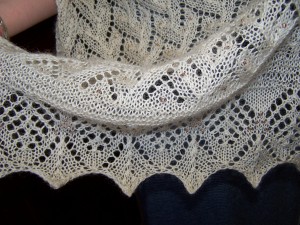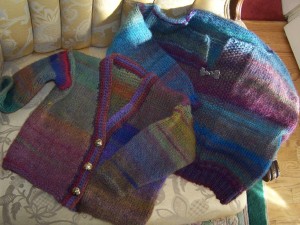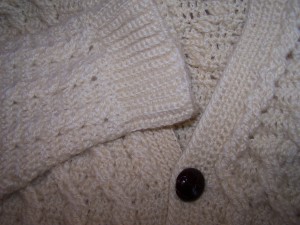Another winter acivity at Meduseld is preparing wool for hand spinning or for sending off to the fiber mill. Yesterday, I spent much of the day cleaning and dying wool. These batches of wool will be combined into a multi color yarn. Following are the steps to clean and dye the wool.
I took Royal’s fleece from last year. She is a lovely purebred Romney ewe who is friendly and always one of the first at the feed trough. She produces a high sheen yarn and she makes about 8 pounds of fleece per year. That is the weight before it is washed of its lanolin. Between that and the loss that always ocurrs during processing, we’ll end up with about half of that in yarn.
First, take the fleece and wash it in the hottest water the tap will provide. Dawn dishwashing soap seems to be a favorite among wool enthusiasts, but we prefer to use organic detergents. Usually, we use Ecover which does a wonderful job removing the grease. You want to make sure you don’t handle the wool too much – its not like hand washing clothes. You want to move it about enough to get it to shake free the dirt and lanolin, but you don’t want to over compensate and felt your fiber. Felting just doesn’t come undone. Rinse several times with hot water until the water comes out clear. I don’t worry about making it crystal clear at this point since I am about to simmer the wool. Here is the cleaned fiber in a large stainless pot.

It is important to use stainless or enamal cookware since we are going to be using Cushings Perfection acid dyes. You don’t want to have a chemical reaction with your pot or stirring spoon, and aluminum will react. I am using a stainless spoon, but I also have a wooden spoon that I reserve just for dying wool.
This is what the Cushing Perfection Dye packets look like. Each packet is costs around $3.00 and will color approximately one pound of wool, although I have had success with larger amounts. Cushing recommends 1/2 cup vinegar per pound of fiber, but you can use more. I used one cup of white vinegar that you can buy at any grocery store. A good pair of rubber gloves would handy, too.

Combine boiling water, the dye packet and the vinegar. Try to eyeball how much water you’ll need to cover the amount of wool you are dying. Cushing says to wet the wool, but ours is already wet from washing. Now, quickly and smoothly, put all your wool in the pot. You have to be rather quick about it, or the portion you put in first is going to be darker than the part to go in last. Stir the fleece around a bit and make sure that all parts are exposed to the dye liquid.
Now, we are going to heat this back up to a simmer and let it stay that way until the wool absorbs the dye. You can see the difference, because suddenly the water will go from being richly pigmented, to suddenly looking almost clear, and your wool will have taken on the dye. It is very important to continue to gently stir periodically during this process so that you achieve even distribution of the color. Here is a picture of my dye pot, and you can see around the edges that the water is still quite dark.

Cotinue stirring until the water clears and look for uniform color in your wool. This blue is turning out nicely, with deep bold coloring.

Take the pot off the stove and drain the wool. Rinse several times in hot water until the water is clear. You don’t want to rinse in cold water because this might cause the wool to felt. It is important to make your temperature changes gradually. I make each rinse slightly cooler so that by the last rinse I can handle the wool.
Now the wool goes out on the drying racks. This time of year it may take several days to dry, especially if the temperatures remain freezing. During the summer, it will dry overnight. Here I have several batches set out to dry.

You can see Cushing’s Blue, Burgundy, and Egyptian Red drying on my porch. When these are dry enough to card, which means to comb the fibers, I’ll have a post on carding and spinning to make a multi-colored yarn.









